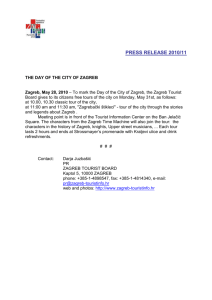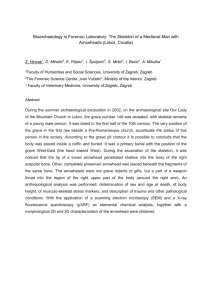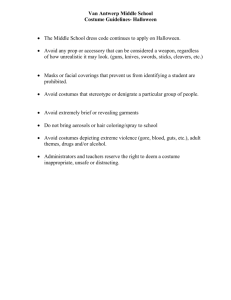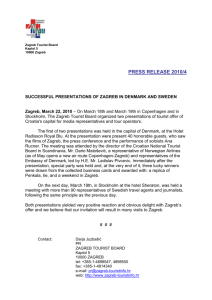MILKA TERNINA AND THE ROYAL OPERA HOUSE
advertisement
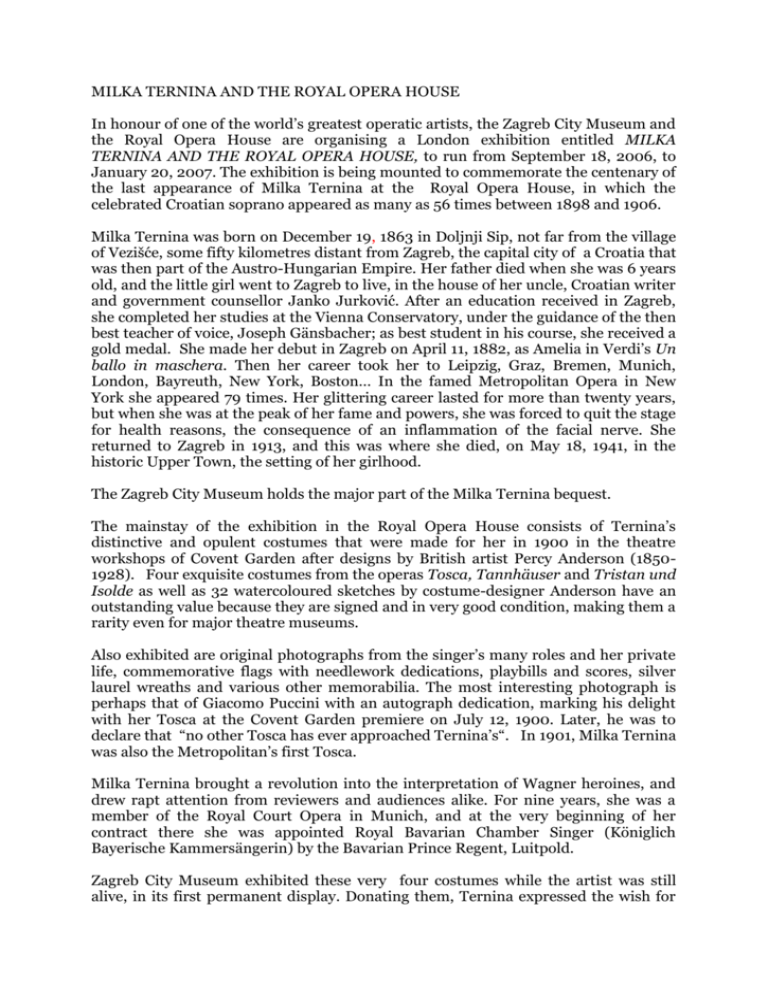
MILKA TERNINA AND THE ROYAL OPERA HOUSE In honour of one of the world’s greatest operatic artists, the Zagreb City Museum and the Royal Opera House are organising a London exhibition entitled MILKA TERNINA AND THE ROYAL OPERA HOUSE, to run from September 18, 2006, to January 20, 2007. The exhibition is being mounted to commemorate the centenary of the last appearance of Milka Ternina at the Royal Opera House, in which the celebrated Croatian soprano appeared as many as 56 times between 1898 and 1906. Milka Ternina was born on December 19, 1863 in Doljnji Sip, not far from the village of Vezišće, some fifty kilometres distant from Zagreb, the capital city of a Croatia that was then part of the Austro-Hungarian Empire. Her father died when she was 6 years old, and the little girl went to Zagreb to live, in the house of her uncle, Croatian writer and government counsellor Janko Jurković. After an education received in Zagreb, she completed her studies at the Vienna Conservatory, under the guidance of the then best teacher of voice, Joseph Gänsbacher; as best student in his course, she received a gold medal. She made her debut in Zagreb on April 11, 1882, as Amelia in Verdi’s Un ballo in maschera. Then her career took her to Leipzig, Graz, Bremen, Munich, London, Bayreuth, New York, Boston… In the famed Metropolitan Opera in New York she appeared 79 times. Her glittering career lasted for more than twenty years, but when she was at the peak of her fame and powers, she was forced to quit the stage for health reasons, the consequence of an inflammation of the facial nerve. She returned to Zagreb in 1913, and this was where she died, on May 18, 1941, in the historic Upper Town, the setting of her girlhood. The Zagreb City Museum holds the major part of the Milka Ternina bequest. The mainstay of the exhibition in the Royal Opera House consists of Ternina’s distinctive and opulent costumes that were made for her in 1900 in the theatre workshops of Covent Garden after designs by British artist Percy Anderson (18501928). Four exquisite costumes from the operas Tosca, Tannhäuser and Tristan und Isolde as well as 32 watercoloured sketches by costume-designer Anderson have an outstanding value because they are signed and in very good condition, making them a rarity even for major theatre museums. Also exhibited are original photographs from the singer’s many roles and her private life, commemorative flags with needlework dedications, playbills and scores, silver laurel wreaths and various other memorabilia. The most interesting photograph is perhaps that of Giacomo Puccini with an autograph dedication, marking his delight with her Tosca at the Covent Garden premiere on July 12, 1900. Later, he was to declare that “no other Tosca has ever approached Ternina’s“. In 1901, Milka Ternina was also the Metropolitan’s first Tosca. Milka Ternina brought a revolution into the interpretation of Wagner heroines, and drew rapt attention from reviewers and audiences alike. For nine years, she was a member of the Royal Court Opera in Munich, and at the very beginning of her contract there she was appointed Royal Bavarian Chamber Singer (Königlich Bayerische Kammersängerin) by the Bavarian Prince Regent, Luitpold. Zagreb City Museum exhibited these very four costumes while the artist was still alive, in its first permanent display. Donating them, Ternina expressed the wish for them to be kept in perpetuity as her “wonderful memories of artistic work and fame,” saying that “they must not depart from Zagreb”. Nor have they ever done, and are kept with deep respect, preserved for the future. This is the first time they have left the city, but we believe that the artist herself would have given her ready assent, for it was with Covent Garden that her best memories were associated. At the time of the restoration and conservation operations on the black costume for Tosca a label was found on the lining, containing the signature of the dressmaker: “Miss Fisher, theatre costumière, 22, Bedford St, 8, Covent Garden”. In concert with costume-designer Anderson, Ternina devised for Act II of Tosca a black gown with gold needlework, semi-precious stones and turquoises. Today, it is practically de rigueur for the costume in Act II to be black. The magnificent costume for Elisabeth in Wagner’s Tannhäuser gives evidence of yet another theatre dressmaker: “M. Nettleship, 58 Wigmore Street”. Ternina was a step in front of her times in thinking the visual component of the role so important. She loved her costumes, spent a great deal of time on them and took part in their creation, and there is no wonder that she should have chosen the best costume designer of the time in London. Designing Ternina’s costumes, Percy Anderson devoted a great deal of attention to details and colour harmony, his imagination conjuring up the spirit and character of a role and making an essential contribution to the dramatic effect on stage. At that time, the costume designer was a new professional in the theatre, and it was not really until the middle of the 20 th century that the work of costume design began to be understood as having an important input in the overall effect of the performance. In theme and chronology, the exhibition presents the life and work of Milka Ternina as a whole, but with a special emphasis on her London career. London was quick to appreciate the value of the work of Ternina, whose achievements were described in Eisenberg's Grosses Biographisches Lexikon der Deutschen Bühne im XIX Jahrhundert , Leipzig, 1903,as "a revelations of perfect art". European and American music reviewers discerned and drew attention to her modern way of acting. They wrote that she “acted with her voice”. In her music theatre expression they discovered new departures in the conception of interpretation. Ternina lived boldly for her art, which she confirmed at the end of her life with the statement: “Artistic life is difficult and painful, but with all that, if I could come into the world again, and could choose, I would select no other vocation”. Zagreb, May 23, 1938. Milka Ternina. Nada Premerl Exhibition: Zagreb City Museum and Royal Opera House ROH, 18 September 2006– 15 January, 2007 Publisher: Zagreb City Museum For the Publisher: Vinko Ivić, Director, ZCM Author of the Exhibition: Nada Premerl Curator of the Exhibition: Marina Perica Exhibition designed by: Cristina Franchi Project associates: Marija Barbieri, Jadranka Beresford-Peirse, Francesca Franchi, Cristina Franchi, Ivan Mirnik, Marina Perica, Đurđa Sorić, Slavko Šterk, Flora Turner Promotion and Marketing: Đurđa Sorić Conservatores: Dora Kušan-Špalj, Iva Čukman, Irena Medić, Ana Vranić Translation into English: Graham Mc Master The leaflet design: Miljenko Gregl Photographs: Miljenko Gregl, Goran Vranić Typeseted and printed by: Laser plus / Denona Copyright 2006 City Museum In September and October , the Ljerka Njers paintings exhibition entitled A Tribute to Milka Ternina will be held at the Croatian Embassy Art Gallery, 21 Conway Street, London.
